The ASUS ZenPad S (Z580CA) Review
by Brandon Chester on August 31, 2015 8:00 AM ESTSystem Performance
A common trend among the tablets I've reviewed in the past few months is that they've used Intel's mobile SoCs rather than the ARM SoCs that you'll see in most tablets and smartphones. All the tablets I've reviewed have come from manufacturers that traditionally made Windows PCs and laptops, and the long-term relationship they would have with Intel is a reasonable explanation as to why they've partnered with Intel for the processors in their tablets. Like both models of the Dell Venue 7000 series, and the top tier model of the ZenFone 2, the ZenPad Z580CA is powered by an Intel Atom Z3580 SoC. This is a quad core Atom part built on Intel's 22nm process, with a max burst frequency of 2.33GHz. In the case of the Z580CA it's paired with 4GB of LPDDR3-1600 memory, which is twice as much as the amount in the Dell Venue tablets.
To evaluate the ZenPad Z580CA's performance I've run it through our standard benchmark suite. The first set is our web benchmarks which is influenced both by a device's browser optimizations as well as its CPU, followed by BaseMark OS II to evaluate several aspects of a device's hardware, and finally PCMark which emulates tasks that a user would perform while actually using a device.
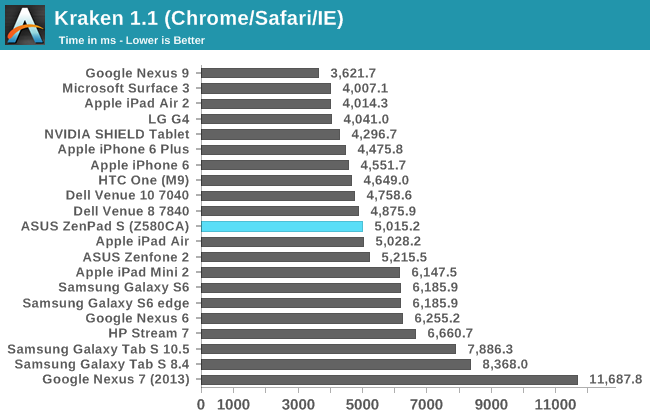
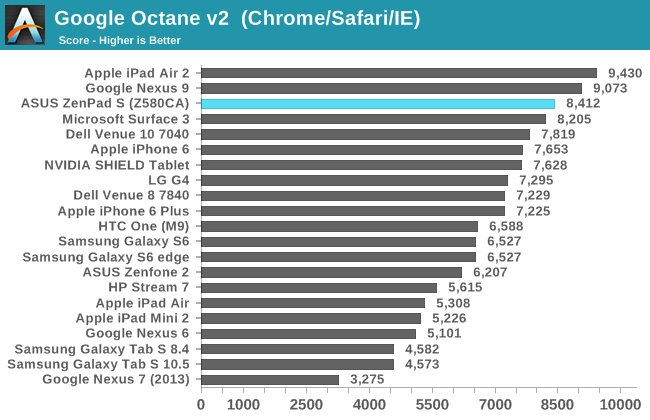

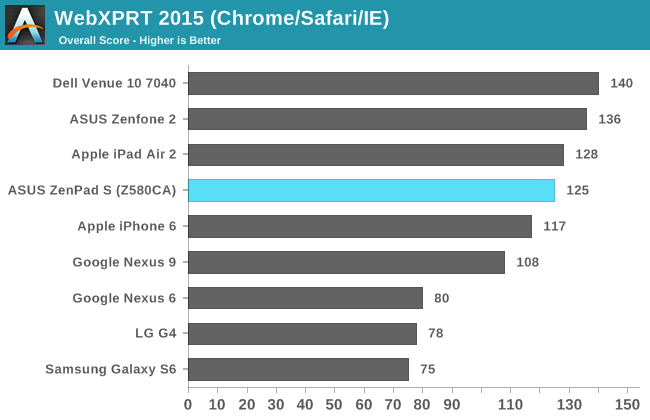
The ZenPad S performs well in our web browser benchmarks. There’s clearly differences at the OS level as well as possible BSP (board support package) differences between the ZenPad and other Intel-based Android devices like the Dell Venue tablets and the ZenFone 2. In Kraken we see a result closer to the middle of our chart, sitting among the Venue 8, Venue 10, ZenFone 2, and Apple’s A7-based iPads. It’s worth noting that as we no longer have those iPads for testing, the results for those devices were performed on iOS 7 and don’t benefit from any enhancements made to Apple’s rendering engine in subsequent releases.
In Google’s Octane benchmark the ZenPad S sits high on the chart with a score that isn’t quite as high as the Nexus 9 or the iPad Air 2, but sitting not far behind. There’s an enormous improvement over the ZenFone 2, and I’m not sure what to attribute this to as both devices use the same hardware platform and both are Android 5.0 underneath ZenUI. Since the test isn’t very long it’s not likely that it has to do with differences in thermal throttling between the two, and most likely is rooted somewhere in the software differences between the ZenFone and the ZenPad.
As for the 2013 and 2015 iterations of WebXPRT, the ZenPad S seems to perform much better in the latter test than it does in the former. While in WebXPRT 2013 it sits behind the iPhone 6 and the Nexus 9, in the 2015 iteration it surpasses both of them. In both cases it’s still behind the iPad Air 2, but for $299 you’re getting a lot of performance for your money.
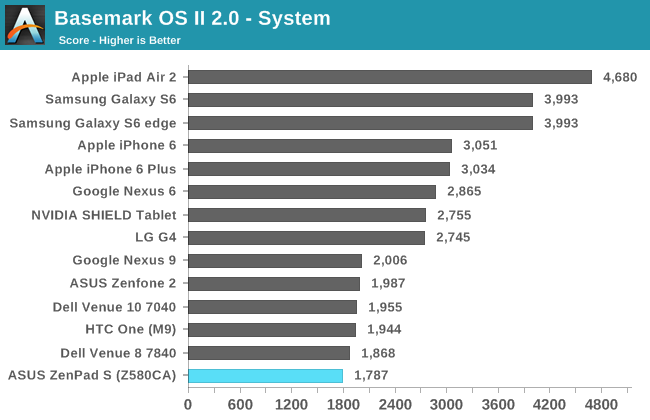
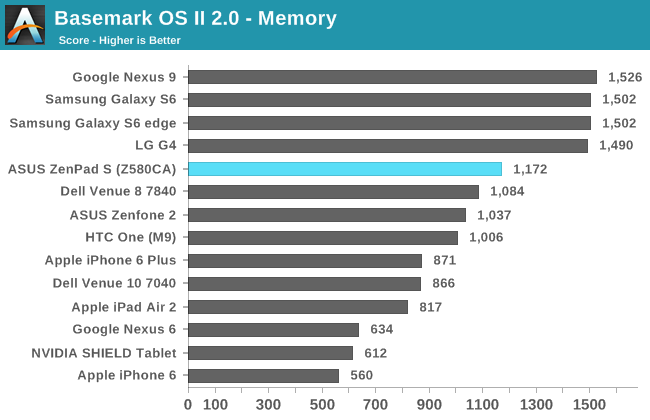
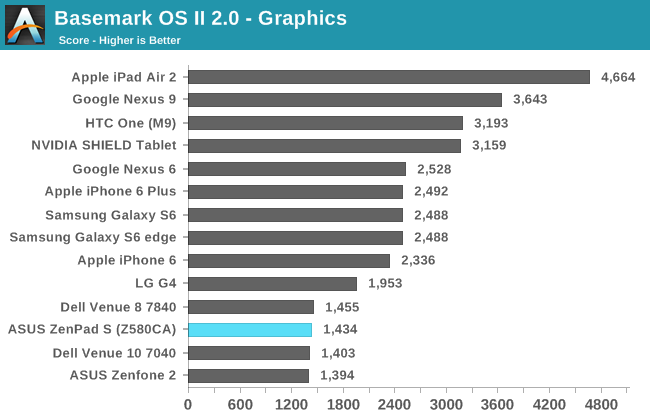

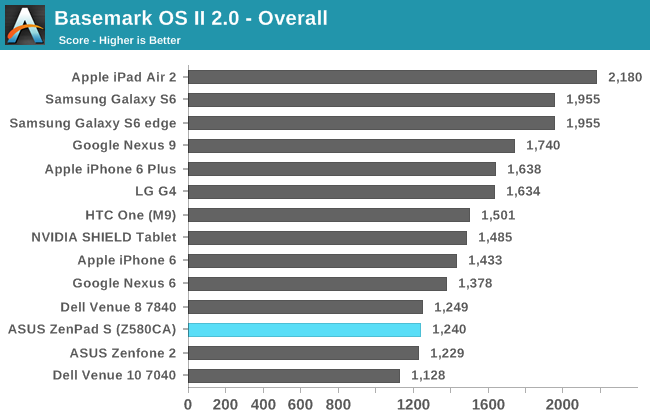
Like all the Intel-based Android devices that I’ve tested, the ZenPad S doesn’t score very high in BaseMark OS II. The score in the graphics sub-test is tied with all the other G6430 devices for last, which says more about how far GPU performance in mobile has come in two years rather than the ZenPad S simply being slow. The score in the system sub-test which stresses the CPU and RAM is the lowest on the chart. In the end all Intel Atom devices don’t perform well in BaseMark OS II, but when a device is $199 like the ZenFone 2 or $299 like the ZenPad S Z580CA I think the performance that the Atom SoC provides is more than sufficient.
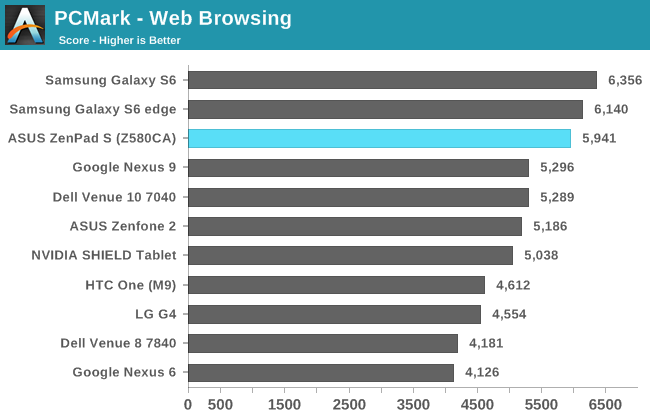
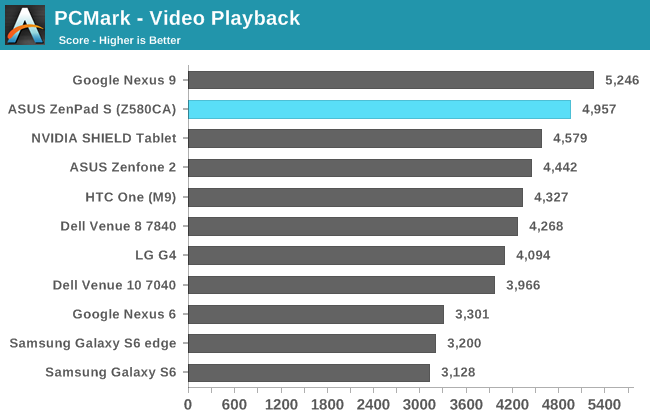

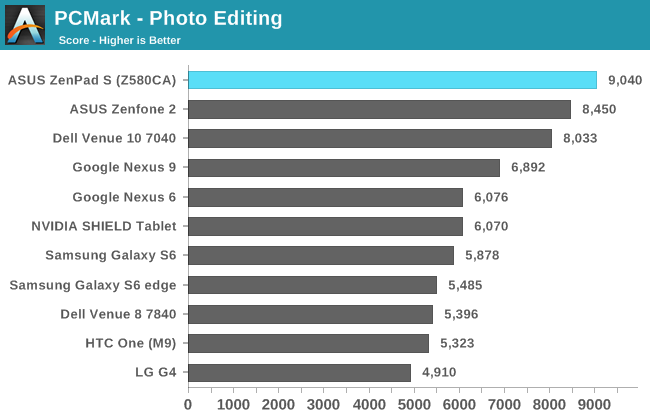

Our final test is PCMark, which emulates tasks that users will perform in the real world like browsing the web, playing and seeking videos, editing photos, and more. The ZenFone 2 performed very well in PCMark, but it ended up being carried to an extent by a disproportionately high photo editing score. The ZenPad S takes this even further with a higher photo editing score, and ends up taking the top spot in the overall ranking. There’s definitely a large software influence in these tests, which isn’t unlike the real world performance that is being tested, which requires both good hardware and optimized software to provide good performance. That being said, I think the ZenPad S ranking first on the basis of its extremely high photo editing score is a little bit questionable, but even without that test it would still score highly overall.
My conclusions about the system performance of the ZenPad S Z580CA are not unlike those in my ZenFone 2 review. When a device is $199 or $299, Intel’s Atom Z580CA SoC is faster than any ARM-based Android device at that price. PCMark doesn’t support iOS, and so there’s no way to know how well the ZenPad S compares to the iPad Mini 2 outside of web performance, but based on the JavaScript benchmark results it’s clear that the ZenPad S should be competitive with it, if not faster.










114 Comments
View All Comments
uhuznaa - Monday, August 31, 2015 - link
Things are strange right now: You can get an 8" (retina) iPad Mini 2 for $299 and at the same time Android tablets are either a little bit cheaper and really crappy or more expensive and not really much better.If even Apple is struggling now to sell iPads I somewhat doubt that such Android tablets are selling great now...
retrospooty - Monday, August 31, 2015 - link
I dont know about that. I got the $199 Asus Zenpad S 8 a month ago and am loving it. Like all Androids from OEM's, you really need to spend a bit of time to root it and debloat it to make it shine. Debloated this thing flies. For $199 you get an 8 inch 2048x1536 screen, 32gb storage + SD, great build quality, thin, light, great battery life, fingerprint resistant on all surfaces and the CPU is great as well. I was worried about using an Atom chip, but in actual use, it runs perfectly smooth and cool as well. In fact cooler than any Snapdragon device I have ever used. It doesnt get hot at all, ever and I live in Arizona and it's summer. EASILY the best "bang for your buck" available in a tablet right now from any vendor.MrSavage - Monday, August 31, 2015 - link
@retrospooty, I agree with you. People who review a product at a certain price point who want to compare that to products that are about 1/3 more expensive? Or they simply omit the good features like the 64GB onboard storage in this situation, or the front facing speakers, the stylus support or the microSD slot? As if the $299, 2-year old iPad mini 2 with 16GB storage is a wiser choice. If the reviewer wants big battery life, best this, and best that? Then add another $100 to the price of the Tab S2 8.0 for all the features it's lacking that the Z580CA has.BurntMyBacon - Wednesday, September 2, 2015 - link
I agree and disagree. You are welcome to compare it to a product that is 1/3 more expensive, so long as you make it known that that product is 1/3 more expensive. If you stress the comparison against a disparate competitor, then you need to stress the price differential as well. I agree it is disingenuous to point out things that may bring value on one side (display quality, build, aspect ratio, etc.) while ignoring the value adds on the other (SD slot, Storage, Stylus, etc,).Note: My comparison is between two imaginary products and has no bearing on products explicitly or implicitly called out in this article or thread. Comparison was made only to illustrate the point that talking about value distinctions without all of the data is impossible. You may not value the items you left out, but the party you are talking to might.
BurntMyBacon - Wednesday, September 2, 2015 - link
@retrospooty: Given what I've read about the new Atoms, I would probably consider it a boon to a tablet rather than a point of worry. A lot of people seem to be on an ARM or nothing kick. While I was pretty enthusiastic about ARM processors (still am) and I love the competition and what it has done for Intel's low end, I now find there is a lot to like about the Atoms in this form factor as well. Atom got a bad name from its netbook days when it was, frankly atrocious for the application. Now it has matured significantly from a performance / watt standpoint and is running an OS that doesn't run like dirt on low end processors. Of course another nicety of the Atom is its ability to support alternate x86 operating systems if you really want to, but then you have to question whether it is capable of giving you the experience you want. ARM will probably move ahead with its A72 in the near future, but that's a good thing. A little back and forth is good for keeping things moving.BugblatterIII - Monday, August 31, 2015 - link
Do not trust Asus to fix issues!I had (and still have) a Transformer Prime. They never managed to get that working acceptably.
Base your buying decision on how it is at launch, and if they do manage to fix the issues then count that as a bonus.
MrSavage - Monday, August 31, 2015 - link
Did you not get the dongle they created? The Prime was a design flaw. They couldn't software fix their way out of it. If you didn't or don't have the dongle, then I suppose blame yourself.invinciblegod - Monday, August 31, 2015 - link
oh REALLY, an external GPS dongle to do what it should have done in the first place? No, no one should blame themselves, they should blame asus for making a bad product.MrSavage - Monday, August 31, 2015 - link
A design flaw is a design flaw. You can hold onto that issue for the rest of your life if you so choose. You want to miss out of price friendly Asus products because of a design flaw on a second even generation, ground breaking device, then be my guest. I bet you didn't even know about the dongle. The fact is the issue was resolved, albeit a lousy solution. Again, you hold that against them for the rest of your life. That's your odd choice, and if you're okay with it, then so am I.3DoubleD - Monday, August 31, 2015 - link
The dongle fiasco was far from the worst of it though - missing GPS on a 10" tablet was really not a big deal. The Transformer Prime was a complete failure in the end due to the TERRIBLE eMMC that was used. Storage performance just plummeted after a time and while the occasional TRIM helped a bit, it was (and still is) painful to use. Once you are in an app... not so bad. Navigating Android was like watching grass grow... very choppy, laggy grass.It was very sad what happened to the Prime... I remember when I first got it, it blew away any Android device I'd ever used. It is one of two electronic device or computer component purchases I've completely regretted buying. (The other was an AGP Radeon x850XT... that was just outright stupidity on my part)
So that experience colors my view of all ASUS products now. They make some nice looking devices that sometimes have great value... but I just can't help think that they are not fully tested. (As for their PC components, I've had nothing but good experiences)